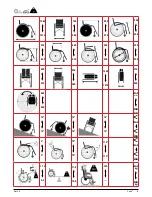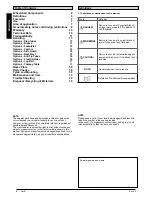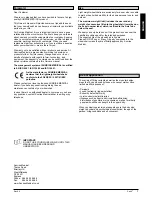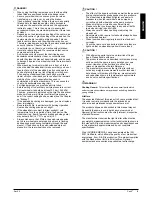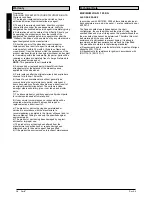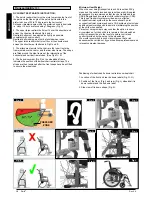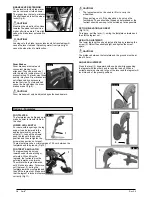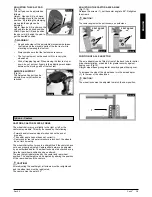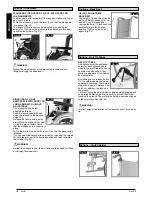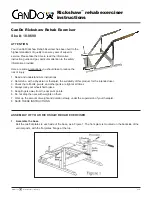
19
PariX
2
ENGLISH
Rev.2.0
Maintenance and Care
HYGIENE WHEN BEING REUSED:
When the chair is to be reused, it should be prepared carefully,
and wiped and treated with spray disinfectant on all surfaces
which could come into contact with the user.
In doing this, you must use a liquid for alcoholic quick
disinfection for medical products and medical inventory when
you require a quick effect. Please pay attention to the
manufacturer’s instructions of the disinfectant you are using.
In general, a safe disinfectant cannot be guaranteed on
seams. We therefore recommend, that you properly dispose of
seat and back slings in the case of micro bacterial
contamination with active agents according to § 6 infection
protection law.
STORAGE
Please store/keep the wheelchair in a dry place.
NOTE:
If the wheelchair has been supplied to you free of
charge it may not belong to you. If it is no longer required follow
any instructions given by the organisation issuing the
wheelchair in order that it may be returned to them.
The following information describes the materials used in the
wheelchair in relation to the disposal or re-cycling of the
wheelchair and its packaging. Specific waste disposal or
recycling regulations may be in force locally and these should
be taken into consideration when disposal arrangements are
made. (This may include the cleaning or decontamination of the
wheelchair before disposal).
Steel:
Fasteners, QR axle, side frames, armrests, frame, leg
rests, push handles.
Plastic:
Hand grips, castor forks, tube plugs, castor wheels,
footplates, arm pads and 12” wheel/tyre, wheels, side
guards.
Aluminium:
Cross brace, foot rest, side guards and castor forks.
Packaging:
Low density polythene bag, cardboard box.
Upholstery:
Woven polyester with PVC coatings and expanded
combustion modified foam.
Disposal or recycling should be done through a licensed agent
or authorised place of disposal. Alternatively your wheelchair
may be returned to your dealer for disposal.
Trouble Shooting
Disposal / Recycling of Materials
WHEELCHAIR PULLS TO ONE SIDE
• Check tyre pressure (pneumatic tyres only).
• Check to make sure wheel turns easily (bearings, axle).
• Check the castor angles are set consistently and make proper
contact with the ground.
• Ensure castor fork bearings rotate freely.
CASTORS BEGIN TO WOBBLE
• Check the castor angle.
• Check to make sure all bolts are secure; tighten if necessary
(see the section on torque).
• Check to make sure both castors are making proper contact
with the ground.
WHEELCHAIR SQUEAKS AND RATTLES
• Check to make sure all bolts are secure; tighten if necessary
(see the section on torque).
• Apply small amount of lubrication to spots where movable
parts
come in contact with one another.
WHEELCHAIR BEGINS TO WOBBLE
• Check angle at which castors are set.
• Check all tyres for damage or wear.
• Check to see if rear wheels are adjusted or fixed unevenly.
MAINTENANCE
• Check the tyre pressure every 4 weeks. Check all tyres for
wear and damage.
• Check the brakes approximately every 4 weeks to make sure
that they are working properly
and are easy to use.
• Change tyres as you would an ordinary bicycle tyre.
• All of the joints that are critical to using your wheelchair safely
are self-locking nuts. Please
check every three months to make sure that all bolts are
secure (see the section on torque).
Safety nuts should only be used once and should be replaced
after use.
• Please use only mild household cleansers when your
wheelchair is dirty. Use only soap and
water when cleaning the seat upholstery and lap belt.
• If your wheelchair should ever get wet, please dry it after use,
to avoid rust and salt corrosion.
• A small amount of sewing-machine oil should be applied to
quick release axles approximately every 8 weeks. Depending
on the frequency and type of use, we recommend taking your
wheelchair to your authorised dealer every 6 months to have it
inspected by trained personnel.
CAUTION!
Sand and sea water (or salt in the winter) can damage the
bearings of the front and rear wheels. Clean the wheelchair
thoroughly after exposure.
The following parts can be removed and sent to the
manufacturer / dealer for repair:
Rear wheels, Armrest, Hanger, Anti – tips. These components
are available as spares. More details can be found in the parts
manual.

